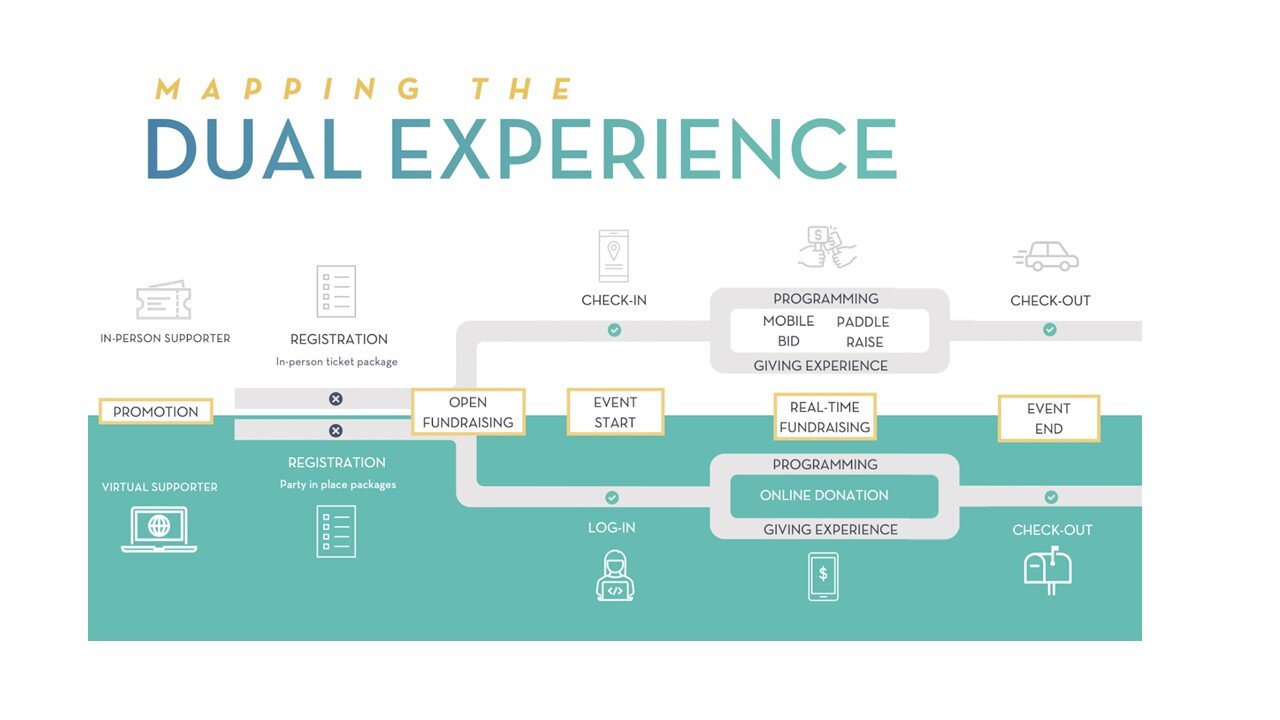
Guest post written by Kelly Velazquez-Hague, Director of Content Marketing, OneCause
After a year of reimagining fundraising events, we’re finally looking ahead toward something approaching normalcy. And while the shift to virtual events was fast and furious, it brought with it new ways to fundraise and reach donors. Many nonprofits are looking to continue to drive engagement by planning and hosting hybrid events.
Hybrid events provide a way to engage dual audiences (in-person attendees and virtual viewers) by creating engaging, inclusive experiences. They offer the best of both worlds: the direct, face-to-face engagement of live fundraising plus the expanded reach and flexibility of virtual events.
However, it’s not simply about livestreaming your in-person events (although that’s important). Your virtual attendees need more than just a screen to watch in order to feel truly connected with your mission. If you haven’t hosted a hybrid event, knowing how to foster connection and inspire virtual supporters can be a challenge.
At OneCause, we’ve helped organizations of all sizes navigate a changed fundraising and event landscape over the past year, and we’re seeing success with hybrid approaches. If you’re wondering what your team can do to ensure a compelling hybrid experience, here are our tips:
-
Plan ahead for both audiences, not just one.
-
Develop an engaging, virtual-friendly program.
-
Create virtual “rooms” to mimic the on-site interaction.
-
Drive real-time engagement and communication.
It really comes down to ensuring your hybrid event is both donor-centric and creates an easy giving experience in order to drive engagement in new ways. Let’s dive in.
Plan ahead for both audiences, not just one.
We’ve written before on data-driven event planning, but when planning a hybrid event, the most important thing to remember is that you are engaging two audiences.
On-site attendees will naturally feel more engaged from start to finish, because they are, well, in-person, experiencing face-to-face connection and real-time interaction. But it’s different for online and virtual supporters. What works in-person won’t always translate to your remote attendees. To make your hybrid event a success, you’ll need strategies to proactively drive engagement with both audiences.
Think high-level about where your giving experiences come together and where they diverge. Find ways to engage both your in-person and at-home attendees throughout the event at those moments of divergence.
Here’s a “map” of how we recommend thinking about your hybrid event’s dual experience:

The most important thing to keep in mind is that you are orchestrating two experiences. Sometimes they overlap and sometimes they require specific attention to ensure a positive, engaging experience.
As you begin planning the in-person aspects of your event, take note of elements that may confuse or be difficult for a virtual audience. Keep a list so that you can directly address these at each stage of the planning process. You may find that you need to:
-
Spend extra time configuring and testing your virtual guest experience and technology.
-
Hire emcees or auctioneers to facilitate the dual fundraising experience.
-
Set up mobile bidding tools if you’re running a silent auction during your event.
-
Leverage livestream technology or virtual event tools.
-
Rethink your registration and check-out processes to accommodate two audiences.
The main idea is to identify elements that might create a clunky experience for both your remote attendees and your onsite supporters. Finding these spots early in the planning process gives you plenty of time to develop varied engagement opportunities.
Hybrid programming and ambassador campaigns
To help make your virtual and in-person experiences compelling and foster human connection, we recommend conducting an ambassador campaign leading up to your event. This form of peer-to-peer fundraising leverages ambassadors to promote your event, creates opportunities for fun pre-event fundraising, and creates a bit of friendly competition before, during, and after the main experience.
These super-charged fundraisers and community builders are the perfect way to broaden giving networks, leverage social fundraising, and drive higher proceeds to the bottom line.
Have your ambassadors attend on-site to take part in the programming. Alternately, you may create teams of in-person and virtual ambassadors to see which side raises the most for your mission – and don’t forget to recognize and reward them at the end.
Ambassador campaigns open up new engagement channels in your hybrid events. Through the use and amplification of social media and social networks, they help your cause reach wider audiences and deepen your relationships with donors.
Develop an engaging, virtual-friendly program.
Once you’ve thought through your dual experience, it’s time to develop your hybrid event program. To generate momentum and energy for both audiences, having a fully fleshed out timeline is very important.
Your program should serve as an event roadmap. It will shape the experiences of both audiences, so give yourself plenty of time to prepare, review, and revise. Consider these tips:
-
Keep your program short – 30-60 minutes – to keep both onsite & virtual attendees focused and engaged.
-
Create and publish a program timeline on your fundraising site. Also, post it on social media, your website, and other communication platforms.
-
Be clear to both audiences about how they will interact and participate in the program.
-
Make use of live and recorded video to ensure a varied program.
-
Show your supporters on-screen to help everyone feel included.
-
Offer additional virtual engagement opportunities both before and after like access to your item catalog, slideshows, live chats, corporate sponsor shout-outs, and separate virtual “rooms” (more on this later).
-
Save the biggest attraction for last. Give everyone a reason to stick around by saving your big-ticket auction items, awards, and/or headline entertainment for later in the program.
The bottom line: Be intentional about how you construct your program to capture and keep attendees’ attention. This will ultimately help keep up engagement for both audiences.
For extra tips and engaging programming ideas, check out the OneCause guide to planning a hybrid event. Here we highlight a few of our favorites, like watch parties, dinner parties, and wine walls.
Create virtual “rooms” to mimic the on-site interaction.
Now for a critical strategy – how to make at-home donors feel like they are in the room where it happens! Remember, virtual attendees don’t want to feel like they’re simply watching a show on a screen, they can do that on Netflix. Take steps to ensure that you are providing alternative experiences and opportunities for fun and engagement with your virtual experience.
One easy solution is to create virtual “rooms” to mimic on-site activities and to create designated engagement spaces during lulls in the on-site event. Examples include:
-
A “party in place” package and dedicated room. Send your remote attendees a package of goodies and offer access to a special virtual room for mingling and celebrating your mission.
-
A virtual cocktail hour room. This separate room can be a space for virtual chats and special appearances or demonstrations from mixologists and sommeliers.
-
Virtual photo journal or guestbook. Use this space to let virtual attendees post photos and stories about what your mission means to them. You might integrate this virtual guestbook with the onsite event by creating a scrolling view of photos and stories on the main on-site display.
-
A virtual ballroom. Avoid simply live-streaming your on-site guests eating or dancing. Instead, open up a virtual room for remote attendees to mingle and enjoy the entertainment, too.
-
Themes and social media engagement. Your Facebook page can essentially serve as its own virtual space for interactions, drawings, and photo contests. Use engaging themes and social media hashtags to drive more interaction during your event.
Robust software specialized for hybrid fundraising events can create a more tailored and inclusive online experience.
Your tools should make it easy for virtual guests to receive updates or announcements, make donations, and place bids at any time. Just like in real life, seamless online experiences make for more engaged, happier supporters. Leverage virtual fundraising technology to create a unified and frictionless experience for your supporters (especially the virtual ones), and they will reward you with longer attention spans, higher conversions, and deeper engagement at your hybrid event.
Drive real-time engagement and communication.
Communication is at the root of donor happiness at all stages of the donor journey. Supporters want to feel that their gifts and time are valued by your organization, so find ways through your hybrid event to make them feel acknowledged and involved.
You’ll need to take extra communication steps to create more engaging on-site and virtual experiences. Prioritize communication through:
-
Social media. Appoint a social media lead to monitor your event’s dedicated hashtags on Facebook, Instagram, and Twitter, as well as actively encourage all attendees to post stories and photos using them. Create mini-contests or prizes for social media engagement during the event, and incorporate them into your programming.
-
Virtual event chat. Similarly to social media, monitor your online chat throughout the event. Engage directly with attendees and be ready to answer any questions or help resolve tech issues as they arise.
-
Auction notifications. If your hybrid event involves an auction, use software that can send automatic outbid notifications. You’ll also need to be able to send broad announcements when items open up for bidding or close out during the course of the event. This OneCause list of top auction software can give you an idea of the types of tools to look for.
As you plan your event, think about exactly how you’ll communicate with attendees at each stage and develop dual-audience tactics where needed. Think back to the roadmap graphic above. At each core stage of the on-site and virtual experiences, outline exactly how you’ll communicate with those attendees.
Reaching people, capturing their attention, and inspiring them to give is the key to hybrid event success. Leveraging diverse and interactive event strategies is your secret weapon to drive hybrid engagement before, during, and throughout your next fundraiser!
Hybrid events are quickly becoming a regular fixture in the nonprofit event landscape. The benefits of opening up your experiences to every supporter regardless of location shouldn’t be overlooked. However, you have to put extra thought and strategy into driving engagement for both audiences for these events to succeed.
Get started planning early, thinking about both the in-person and virtual experiences at every step. Create a virtual-friendly program or schedule from the start, then make sure to offer engaging alternative activities and plenty of communication outlets.

About Kelly
Kelly Velasquez-Hague brings over 20 years of fundraising, nonprofit management, and sales/marketing experience to her role as the Director of Content Marketing for OneCause. As a member of the OneCause sales and marketing team, Kelly manages all of the company’s content strategy and execution. She is passionate about empowering great missions and loves that her current role allows her to continue to help nonprofits reach new donors raise more funds for their cause.
